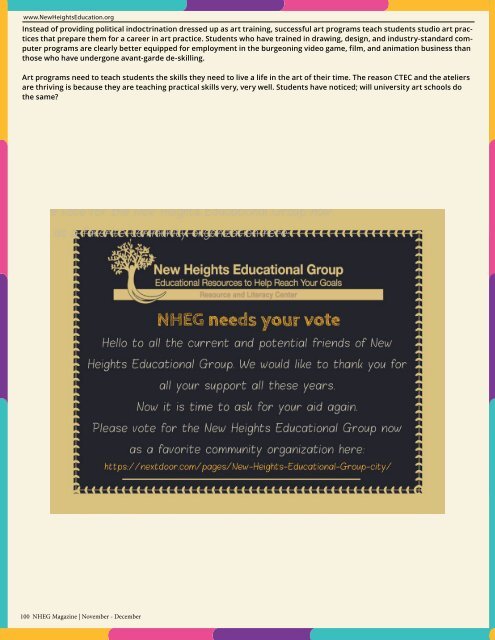NHEG-Magazine-November-December
You also want an ePaper? Increase the reach of your titles
YUMPU automatically turns print PDFs into web optimized ePapers that Google loves.
www.NewHeightsEducation.org<br />
Instead of providing political indoctrination dressed up as art training, successful art programs teach students studio art practices<br />
that prepare them for a career in art practice. Students who have trained in drawing, design, and industry-standard computer<br />
programs are clearly better equipped for employment in the burgeoning video game, film, and animation business than<br />
those who have undergone avant-garde de-skilling.<br />
Art programs need to teach students the skills they need to live a life in the art of their time. The reason CTEC and the ateliers<br />
are thriving is because they are teaching practical skills very, very well. Students have noticed; will university art schools do<br />
the same?<br />
Charters Have<br />
Achieved Their<br />
Original Goal:<br />
Innovation<br />
www.NewHeightsEducation.org<br />
Charter schools questioned the low expectations<br />
that schools place on poor<br />
students and challenged the now popular<br />
assumption that student-led project<br />
learning is the best practice<br />
By Daniel Buck<br />
Friday, May 31, 2019<br />
Exasperated by apathetic students and a heap of failed tests, a fellow teacher recently asked me and several peers a question<br />
as we ate lunch: “What’s the solution?”<br />
He couldn’t figure out how to engage his class.<br />
Few classrooms are ever empty at my school, one of the largest in Wisconsin, so prep periods are spent in cubicle-filled staff<br />
lounges where all conversations are basically public. While a little too public for most, this communal setup does provide a<br />
unique way to look for answers to that exasperated teacher’s question.<br />
Teach Like a Champion<br />
Specifically, most of my coworkers have on display some collection of their favorite pedagogy and general education books.<br />
Shelves vary by subject area and personal focus, but there is one book that is ubiquitous across shelves: Teach Like a<br />
Champion.<br />
Despite its profound effect on American schools, this book is unknown outside of education. The original edition sold 800,000<br />
copies, and a second edition has surely put that number over a million. Its author, Doug Lemov, is the managing director of<br />
Uncommon Schools, one of America’s foremost charter school networks that is achieving results. Teaching a student body<br />
with a poverty rate of 82 percent—far above the national average—they still achieve high tests scores and a 99 percent college<br />
acceptance rate. Perhaps most importantly, they have shared their innovations outside of their organization.<br />
Rather than keeping their techniques secret, Lemov spent years with a notebook observing the best teachers in the system,<br />
trying to find commonalities. In the end, he determined 49 techniques that created success for students, compiled them into a<br />
book, and disseminated the information across the country. Now, few schools remain outside the influence of his work (to at<br />
least some degree).<br />
The book garners valid criticism. It advocates for a regimented style, keeping classrooms teacher-centered and rote, but it<br />
fosters a teaching method that boosts test scores and graduation rates among poor students unlike any other. Should it be<br />
adopted uniformly across schools? Probably not, but its strict implementation has a place in many, and countless more can<br />
adopt different elements to fit diverse needs.<br />
Charter Schools Lead to Innovation<br />
Though this book shaped my early career, I had forgotten about it until Bernie Sanders proposed banning charters in his education<br />
platform, “A Thurgood Marshal Plan for Public Education.” In reading commentary on it, most criticism—both conservative<br />
and liberal— focused on the benefit charters provide disproportionately to poor and minority students. While an important<br />
point, missing was the benefit that charters provide to even those teachers and students who have never attended one.<br />
100 100 <strong>NHEG</strong> | GENiUS <strong>Magazine</strong> MAGAZINE | <strong>November</strong> | www.geniusmag.com<br />
- <strong>December</strong><br />
According to FEE’s Kerry McDonald, reformers created charter schools “to encourage educational experimentation and innovation.”<br />
As our factory model of education pushes students through monotonous standards, bipartisan reformers recommended<br />
charter schools as little laboratories where new teaching techniques and school structures could be tried. The argument<br />
ran that free of oversight and ancillary to a district, educators could try new practices.<br />
<strong>November</strong> - <strong>December</strong> 2019 | <strong>NHEG</strong> <strong>Magazine</strong> 101


















